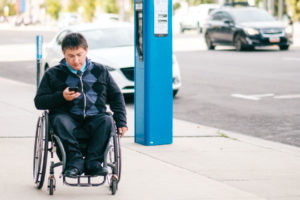By Renee Smith, JD MBA
Canada’s cities have long struggled with how to make their streets (and sidewalks and neighborhoods) more accessible to people with disabilities. There are many barriers to handicap access, including curbs bordering sidewalks, paucity of parking spaces designated solely for use by people with disabilities, and inaccessible buses and other forms of public transportation for people who don’t want to drive into the heart of the city. Add to that snow drifts, which are a common presence on our streets and sidewalks, and it’s easy to understand why it can be so difficult for people with disabilities to often struggle in our cities.
One area where cities sometimes fall short when it comes to accessibility is parking. That’s because it’s easy to fall into the trap of only addressing the most obvious accessibility issues, such as the size and location of parking spaces for people with disabilities. These are obviously important issues, but they only address part of the issue.
For many cities accessibility often ends at the curb cut. Parking planners tend to do a good job of making it easy to find appropriate parking and get safely out of vehicles and onto sidewalks. However, they don’t always give as much thought to their parking equipment, particularly meters and parking payment machines.
Impossible To Use
Not all parking equipment is designed with the needs of people with disabilities in mind, and older equipment can be particularly problematic. It’s often too tall or poorly designed for them to use, particularly those in wheelchairs. With the advent of pay-on-foot systems and smart meters, payment kiosks have become a common sight in cities. Unfortunately drivers with disabilities, particularly those in wheelchairs, sometimes can’t use these meters and kiosks because the credit card slots and cash receptacles in the equipment…
By Ralph Bond
The recent Ontario provincial election saw the high price of hospital parking for patients and visitors pop up as an issue.
As the population ages and more of us utilize hospital services and the cost of providing parking in rapidly urbanizing areas continues to increase, this hot topic is likely to keep sizzling over the next decade. The issue is more complicated than it first appears.
Historically, the province has funded approximately 75% of hospital capital and operating costs and relied on the local hospital to fund the remainder by generating surplus revenues from services like parking, retail stores, coffee shops and cafeterias. This has lead over time to the standard practice of parking facilities at hospitals being self- financing.
Perhaps the best way to start a conversation about hospital parking is to understand what it costs to provide it. This includes development costs, operating, maintenance and capital repair costs as well as replacement cost over the long term life cycle of the facilities. The cost of construction will vary significantly depending on whether the parking is in surface lot, above ground parking garage or an underground garage or some combination thereof.1 In the Greater Toronto Area (GTA), a surface parking space would likely cost approximately $15,000 per space to build including land costs. An above ground parking garage would likely cost approximately $35,000 per space while underground parking would be about $50,000 per space. The general trend is towards less surface parking and more garage parking as land becomes scarce and hospitals continue to expand into the surface lots. This means the cost of providing parking is likely to increase significantly into the future.
One also has to consider the cost to operate the parking which would include items like hydro for the lighting, parking access and revenue…




